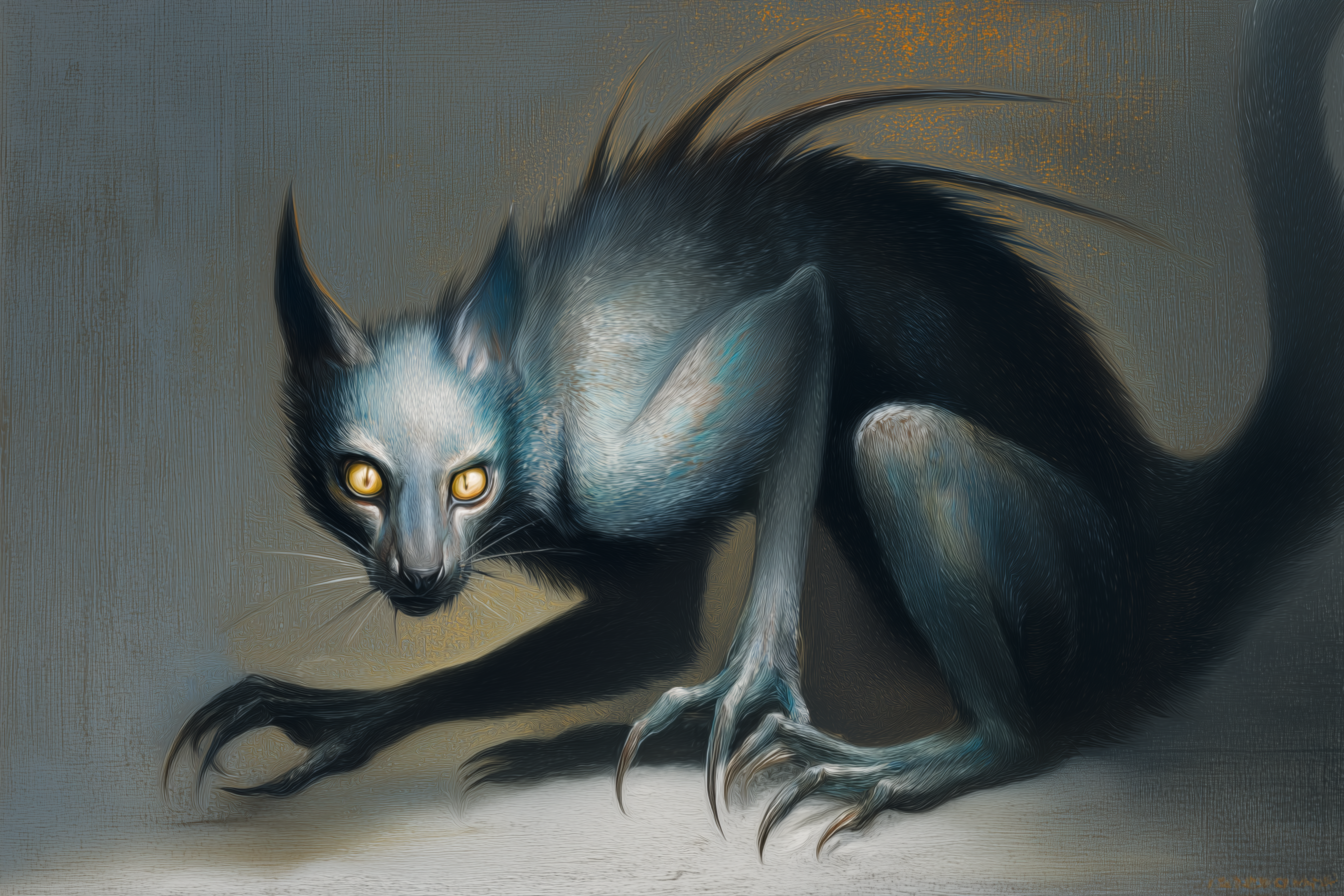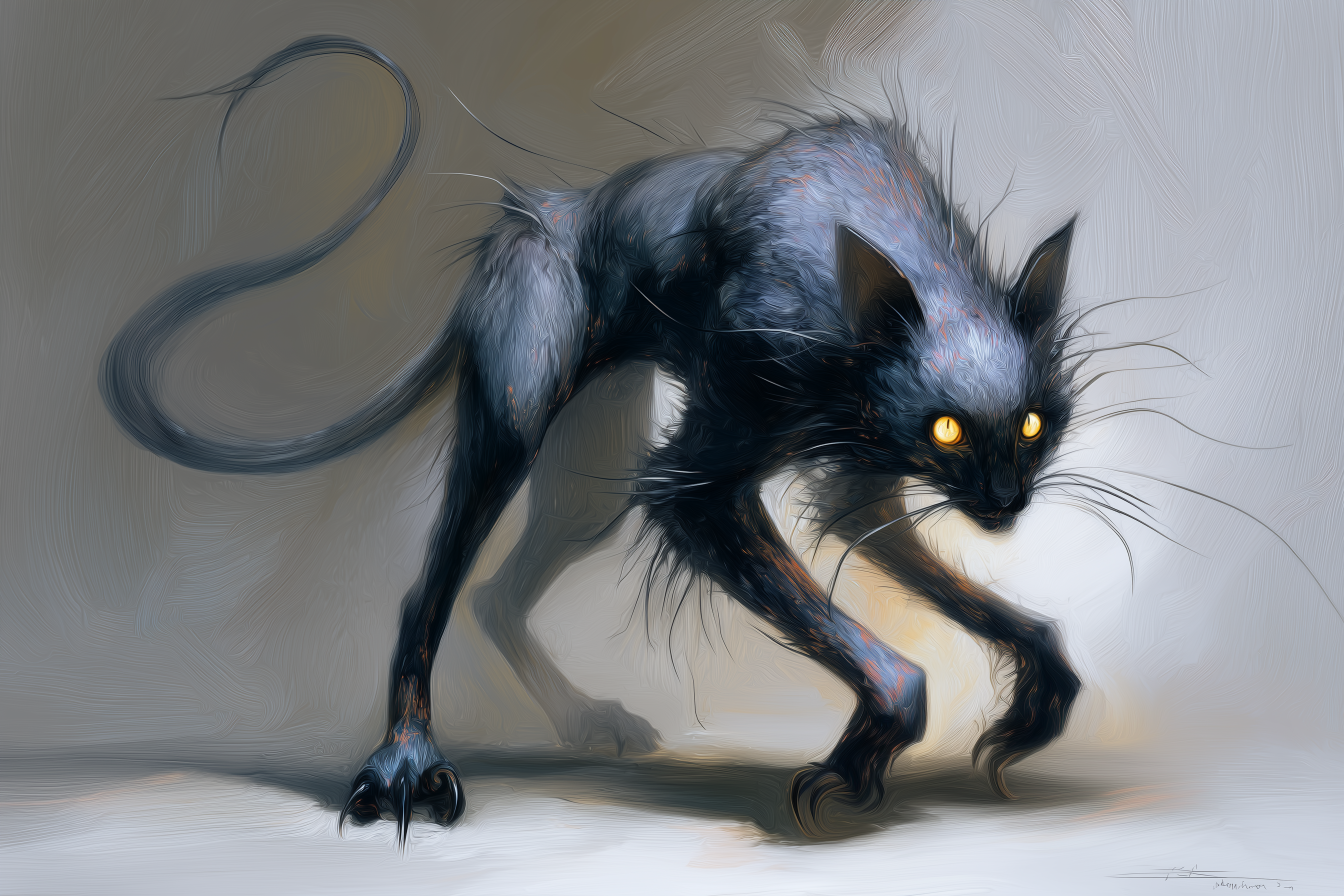Bandersnatch, Frumious Harbinger of Whimsy
“Swift as a nightmare and twice as mad — the frumious Bandersnatch strikes before you even know you’re doomed!”

“Beware the frumious Bandersnatch…” — common advice, too often given too late.
The Bandersnatch is a lithe, sinewy predator standing between 8 to 10 feet tall, with elongated limbs that flex at unnatural angles. Its fur shimmers with a sickly, ever-shifting iridescence, like heat-haze over oil. A wide, lipless mouth bristles with needle-thin teeth, perpetually twisted into a grin, while six reflective eyes rove independently, scanning all directions. Its claws—long, semi-corporeal talons—appear to flicker in and out of phase, leaving the air around them scorched and vibrating.
Behavior
Highly intelligent and unnervingly fast, the Bandersnatch processes information at speeds that outpace mortal comprehension. It is aggressive but calculated, preferring to assess its prey over time before striking. Bandersnatches rarely act without overwhelming advantage. Their presence often triggers hallucinations, temporal disorientation, or sudden flashes of irrational thought in nearby creatures. Eye contact, or even seeing one indirectly, can distort perception and memory.
Habitat
Bandersnatches originate from fractured dream-realms and logical dead zones—places like the Mirrorwilds, the Raveled Depths, or dimensional fault lines where causality breaks down. In the waking world, they are sometimes found near cursed mirrors, abandoned observatories, or locations touched by time anomalies. They are drawn to instability, slipping through when the boundary between reality and madness grows thin.
Modus Operandi
A Bandersnatch does not merely hunt—it studies. It may stalk prey for days, subtly influencing its surroundings: rearranging items, distorting memories, or planting nonsense in dreams to unravel mental defenses. When it chooses to strike, it moves in a blur of impossible angles, as if ignoring the laws of momentum and space. Its claws do not simply cut flesh—they disrupt probability itself, turning certainty into failure and success into catastrophe.
Motivation
Bandersnatches are not driven by hunger, but by paradox. They are drawn to minds on the brink: philosophers obsessed with recursion, prophets caught in loops of fate, or mages unraveling forbidden theorems. Their sustenance is not physical; they feed on contradiction, extracting power from the collapse of coherent thought. Some theorists believe they are not predators at all, but manifestations of fractured logic given form and fury.
Legends claim that speaking the Bandersnatch’s name aloud draws its attention. Writing it down only hastens its approach.
Bandersnatch 5e
Bandersnatch Pathfinder
Bandersnatch

Large Fey, Chaotic Neutral
Challenge 11 (7,200 XP) Proficiency Bonus +4
“The frumious Bandersnatch — it doesn’t live in time, it dances through it.”
Armor Class 18 (natural armor)
Hit Points 154 (18d10 + 54)
Speed 50 ft., climb 30 ft.
Ability Scores
| STR | DEX | CON | INT | WIS | CHA |
|---|---|---|---|---|---|
| 17 (+3) | 22 (+6) | 16 (+3) | 16 (+3) | 14 (+2) | 18 (+4) |
Saving Throws Dex +10, Wis +6, Cha +8
Skills Deception +8, Insight +6, Perception +10, Stealth +12
Damage Resistances psychic, force, radiant; bludgeoning, piercing, and slashing from nonmagical attacks
Condition Immunities charmed, frightened, confused
Senses darkvision 120 ft., passive Perception 20
Languages Sylvan, Common; understands all languages but speaks only in riddles
Proficiency Bonus +4
Traits
Whimsy-Warp Aura (30 ft.)
At the start of each creature’s turn within 30 feet, the Bandersnatch can force it to make a DC 16 Wisdom saving throw, or suffer one of the following effects (roll 1d4 or choose):
- Backwards Breath. The creature speaks in reverse and cannot cast spells with verbal components until the start of its next turn.
- Topsy-Turvy Logic. The creature must move in a random direction (roll 1d8 for compass direction).
- Pocket of Unreason. The creature takes 10 (3d6) psychic damage and cannot distinguish friend from foe until the end of its turn.
- Vanishing Thought. The creature forgets one prepared spell or known ability (GM’s choice) until it finishes a short rest.
A creature that succeeds on the saving throw is immune to this effect for 24 hours.
Flickering Dash (Recharge 5–6)
As a bonus action, the Bandersnatch teleports up to 60 feet to a space it can see, ignoring line of sight if the destination is in dim light, through a mirror, or behind a veil, curtain, or similar cover. It can pass through reflective or illusory surfaces as if they were difficult terrain.
Nonsense Logic
The Bandersnatch is immune to effects that rely on logic, truth, or reason—such as zone of truth, command, suggestion, or similar magic that requires coherent communication or rational thought.
Wyrd Fate (3/Day)
When a creature within 60 feet makes a d20 roll, the Bandersnatch can twist fate. The creature rolls a d6:
- 1–2: The roll becomes a natural 1.
- 3–4: The creature has disadvantage.
- 5–6: The creature’s roll is swapped with another creature’s last d20 roll (GM’s choice).
Actions
Multiattack
The Bandersnatch makes two Claw of Curved Time attacks and may use Laughter in the Walls, if available.
Claw of Curved Time (Melee Weapon Attack)
+10 to hit, reach 10 ft., one target.
Hit: 16 (2d10 + 5) slashing damage plus 5 (1d10) psychic damage.
If the target has used its reaction this round, it has disadvantage on its next saving throw.
Laughter in the Walls (Recharge 5–6)
The Bandersnatch emits a wave of warped sound and thought in a 30-foot radius. Each creature of its choice in that area must succeed on a DC 16 Wisdom saving throw or fall prone, incapacitated and giggling uncontrollably until the end of its next turn.
Bonus Action: Crooked Step
The Bandersnatch blurs between seconds. Until the start of its next turn, it has resistance to all damage, and attacks against it are made with disadvantage unless the attacker is immune to charm or can see through illusions.
Tactics
- Ambusher. Prefers chaotic terrain—mirrors, gardens, mazes—and strikes from concealment.
- Trickster. Focuses on confusing and disabling spellcasters or intelligent opponents.
- Hit-and-Flicker. Uses Flickering Dash and Crooked Step to strike, evade, and reappear unpredictably.
Legendary Actions (Optional for Elite Encounters)
The Bandersnatch can take 2 legendary actions, choosing from the options below. Only one legendary action can be used at a time and only at the end of another creature’s turn.
- Fey Flicker. The Bandersnatch moves up to 20 feet without provoking opportunity attacks.
- Word Knot. One creature within 30 feet must succeed on a DC 16 Intelligence saving throw or become silenced (unable to speak or cast spells with verbal components) until the end of its next turn.
- Turn the Clock (Costs 2 Actions). One creature must repeat its last action on its next turn, regardless of the outcome or context.
Variant: Agent of the Mirror Courts
Some Bandersnatches serve powerful Fey Lords or Ladies—often as messengers, assassins, or enforcers of riddles and paradoxes. Those bound to the Court of Reflections gain the ability to cast mirror image once per day and may pass freely between any two mirrors on the same plane.
Bandersnatch

This beast stalks forward with a fluid grace. Barbed quills run along its back, and its eyes glow with a blue light.
Bandersnatches are consummate hunters, and only the deadliest predators or the most cunning intelligent prey offer them sport. Once a bandersnatch has marked a creature for death, it runs it to ground without fear, rest, or remorse.
Bandersnatches rely on speed, shock, and terror to bring down prey. They pace their quarry from a distance, hidden among the trees, then break from cover, savage their target, and dart away again. They drag smaller creatures away to dispatch at leisure, while engaging larger ones in skirmishes until they gradually wear their prey down. An outmatched bandersnatch withdraws at full speed, stopping only to pick off pursuers that distance themselves from their allies. Once its wounds heal, the bandersnatch returns to the scene of its defeat, picks up the trail of its assailants, and eliminates them one by one.
In appearance, they resemble a great cat, but with wickedly barbed quills running the length of its body and down to the tip of its long, flexible tail. Its quills serve to deter attackers, but also act as a formidable weapon. With a single flick of its muscular tail, they can fling as many as a half-dozen quills at distant foes with surprising accuracy. It captivates any prey that meets the gaze of its saucerlike, luminous eyes. A bandersnatch measures 40 feet in length plus another 10 feet of tail and weighs 12,000 pounds. Despite their bulk, they move with speed, grace, and even considerable stealth when required.
Bandersnatches were once native to the primal world of the fey, where they preyed on the greatest hunters of that ancient realm. As with other legendary creatures from this realm, such as the jabberwock, bandersnatches belong to a group of creatures known collectively as the “Tane.” Whether the fey were careless in guarding their portals or released the first bandersnatches into Material Plane deliberately cannot be said with certainty.
Rare in the extreme on the Material Plane, bandersnatches lair within forgotten forests where ancient beasts walk the world. Bandersnatches mate only rarely. A female becomes fertile perhaps once or twice per century, leaving the male soon after mating and giving birth to only one or two kittens per litter. The mother brings meat to her ravenous young, which mature into lesser bandersnatches (see below) within a year. Bandersnatches live for a thousand years or longer.
Bandersnatch Pathfinder Stat Block
| Bandersnatch CR 17 |
| XP 102,400 N Gargantuan magical beast Init +11; Senses Blindsense 120 ft., Darkvision 120 ft., Low-Light Vision, Scent; Perception +26 |
| DEFENSE |
| AC 33, touch 13, flat-footed 26 (+7 Dexterity, +20 natural, -4 size) hp 310 (23d10+184); fast healing 10 Fort +21, Ref +20, Will +11 Defensive Abilities quick recovery, quill defense; Immune fear, Paralysis, poison, sleep |
| OFFENSE |
| Speed 60 ft., Climb 20 ft. Melee bite +32 (2d8+13 plus grab), 2 claws +32 (2d6+13/19-20), tail slap +27 (2d8+19/x3 plus pain) Ranged 4 quills +26 (1d10+13/19-20) Space 20 ft.; Reach 15 ft. (20 ft. with tail slap) Special Attacks bounding charge, brutal tail, gaze, lash out, pounce, rake (4 claws, +32, 2d6+13/19-20), rend (2 claws, 2d6+19) |
| STATISTICS |
| Strength 36, Dexterity 25, Constitution 27, Intelligence 2, Wisdom 15, Charisma 18 Base Atk +23; CMB +40 (+44 grapple); CMD 57 (65 vs. trip) Feats Bleeding Critical, Combat Reflexes, Critical Focus, Critical Mastery, Exhausting Critical, Improved Critical (claws), Improved Critical (quills), Improved Initiative, Improved Iron Will, Iron Will, Skill Focus (Stealth), Tiring Critical Skills Acrobatics +19 (+31 when jumping), Climb +21, Perception +26, Stealth +18 (+26 forests), Survival +3 (+23 tracking); Racial Modifiers +8 Acrobatics, +10 Perception, +4 Stealth (+12 forests), +20 Survival when tracking SQ planar acclimation, relentless tracker |
| SPECIAL ABILITIES |
| Bounding Charge (Ex) A bandersnatch can move through difficult terrain when it charges. Brutal Tail (Ex) The quills and barbs on a bandersnatch’s tail cause triple damage on a critical hit from its tail slap. A bandersnatch adds 1-1/2 times its Strength bonus on attack rolls when using its tail slap. Gaze (Su) Confused, range 30 feet, Fortitude DC 29 negates. A bandersnatch can direct its gaze attack against a single foe as a swift action. This is a mind-affecting compulsion effect. The save DC is Constitution-based. Lash Out (Ex) As a swift action, a bandersnatch can make a single attack with a bite, claw, or tail slap. A bandersnatch cannot lash out on the same round it charges. Pain (Ex) Whenever a creature takes damage from a bandersnatch’s tail slap attack, quills, or quill defense, that creature must make a DC 28 Reflex save or a quill lodges in its flesh, causing the creature to become sickened until the quill is removed. Removing one quill requires a DC 20 Heal check made as a full-round action. For every 5 by which the check exceeds the DC, one additional quill can be removed. On a failed check, a quill is still removed, but the process deals 1d10+6 points of damage to the victim. The save DC is Dexterity-based. Planar Acclimation (Ex) A bandersnatch is always considered to be on its home plane, regardless of what plane it finds itself upon. It never gains the extraplanar subtype. Quill Defense (Ex) Any creature that strikes a bandersnatch with a non-reach melee weapon, unarmed strike, or natural weapon takes 1d10 points of piercing damage from the bandersnatch’s quills and suffers from the bandersnatch’s pain attack. Quick Recovery (Su) A debilitated bandersnatch recovers with frightening speed. If a bandersnatch starts its turn affected by any or all of the following conditions, these conditions end at the end of its turn: confused, dazed, dazzled, exhausted, fatigued, nauseated, sickened, and stunned. Furthermore, a bandersnatch affected by ability damage, ability drain, or a mind-affecting effect that allows a save receives a single additional save against the effect of its choice at the original DC at the end of its turn in order to shake off the effect. Quills (Ex) With a snap of its tail, a bandersnatch can loose a volley of four quills as a standard action (make an attack roll for each spike). This attack has a range of 300 feet with no range increment. All targets must be within 30 feet of each other. Launched quills regrow in a single round, during which the bandersnatch’s defensive abilities are unaffected. Relentless Tracker (Ex) A bandersnatch can move at up to double its speed and still track without penalty. It gains a +10 competence bonus on Survival checks made to track creatures it has wounded. |
| ECOLOGY |
| Environment any forests Organization solitary Treasure incidental |
Variants
Though none of them are ordinary, some are rarer than others. The most famous is the frumious bandersnatch, brimming with rage so fierce it burns. Variant bandersnatches may combine two or more of the abilities below.
Confounding Bandersnatch (CR 18): Confounding bandersnatches drip infectious madness from their quills and claws. Poison (Ex) Claws and quillsinjury; save Fort DC 29; frequency 1/minute for 6 minutes; effect confused for 1 minute; cure 2 consecutive saves. The save DC is Constitution-based.
Frumious Bandersnatch (CR 19): This creature seethes with barely repressed rage and anger. If it misses with its bite attack or falls below half of its hit points, it succumbs to such uncontrollable fury that it bursts into flame. While engulfed in these flames, a frumious bandersnatch is affected as by a haste spell (this effect cannot be dispelled) and causes an additional 2d6 points of fire damage with each of its melee attacks and its quill defense ability. The fury lasts for 5 rounds, after which the bandersnatch cannot enter a fury again for another 5 rounds. They have a fire resistance 30.
Lesser Bandersnatch (CR 13): Smaller or younger bandersnatches are still fearsome predators in their own right. A lesser bandersnatch is Huge, with 4 fewer Hit Dice than a typical bandersnatch. Reduce its physical ability scores by 4 each and its Wisdom and Charisma by 2 each. A lesser bandersnatch lacks quick recovery and deals 1d8+4 points of damage with its quill defense and pain abilities. Lesser bandersnatches never have any additional variant powers.
Magicbane Bandersnatch (CR 20): These creatures radiate an Antimagic Aura in a 20-foot radius. Should the aura be brought down, it returns automatically as a free action on the bandersnatch’s next turn. Magicbane bandersnatches lack gaze and quick recovery.
Primal Bandersnatch (CR 19): Primal bandersnatches have kept their ties to the ancient world of the fey. They have the extraplanar subtype, SR 30, DR 10/cold iron, and the advanced creature simple template.
Section 15: Copyright Notice – Pathfinder Roleplaying Game Bestiary 3
Pathfinder Roleplaying Game Bestiary 3, © 2011, Paizo Publishing, LLC; Authors Jesse Benner, Jason Bulmahn, Adam Daigle, James Jacobs, Michael Kenway, Rob McCreary, Patrick Renie, Chris Sims, F. Wesley Schneider, James L. Sutter, and Russ Taylor, based on material by Jonathan Tweet, Monte Cook, and Skip Williams.

 Buy me a coffee
Buy me a coffee